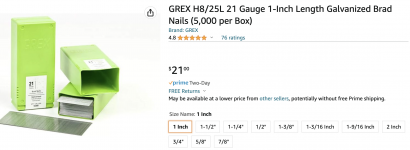smorgasbord
Member
Been using my trusty old Hitachi 18-ga brad nailer for trim jobs (like baseboards), but thinking about going for a 21 and/or 23 gauge nailer where I don't need the 2" length and want a smaller hole. The 23-gauge would be for where I can't easily clamp something while the glue dries.
Senco introduced two 23-gauge and one 21-gauge nailers just a couple/few years ago that are oil-less. This is intriguing for me, I never like oiling my Hitachi and my oil-less compress has lasted decades (although I am replacing that with a quieter one).
Anyway, there aren't many reviews on the Sencos (models TN21L1, TN11L1, and TN11G1 - don't ask me why the 21 gauge is TN21L2 while the 23 gauge isn't TN23L1). Maybe they just haven't been around long enough, but anyone here use them?
I could just get the Metabo HPT NP35A, which is a 23-gauge pin nailer for $80. Apparently Metabo bought Hitachi's power tool division out some years ago.
I know the Cadex and Grex get pretty decent reviews, too, but like the idea of going oilless with the Sencos. I know many carpenters that swear by their Sencos, but also that perhaps their quality has gone down since Kyocera bought them out in 2017.
Senco introduced two 23-gauge and one 21-gauge nailers just a couple/few years ago that are oil-less. This is intriguing for me, I never like oiling my Hitachi and my oil-less compress has lasted decades (although I am replacing that with a quieter one).
Anyway, there aren't many reviews on the Sencos (models TN21L1, TN11L1, and TN11G1 - don't ask me why the 21 gauge is TN21L2 while the 23 gauge isn't TN23L1). Maybe they just haven't been around long enough, but anyone here use them?
I could just get the Metabo HPT NP35A, which is a 23-gauge pin nailer for $80. Apparently Metabo bought Hitachi's power tool division out some years ago.
I know the Cadex and Grex get pretty decent reviews, too, but like the idea of going oilless with the Sencos. I know many carpenters that swear by their Sencos, but also that perhaps their quality has gone down since Kyocera bought them out in 2017.


